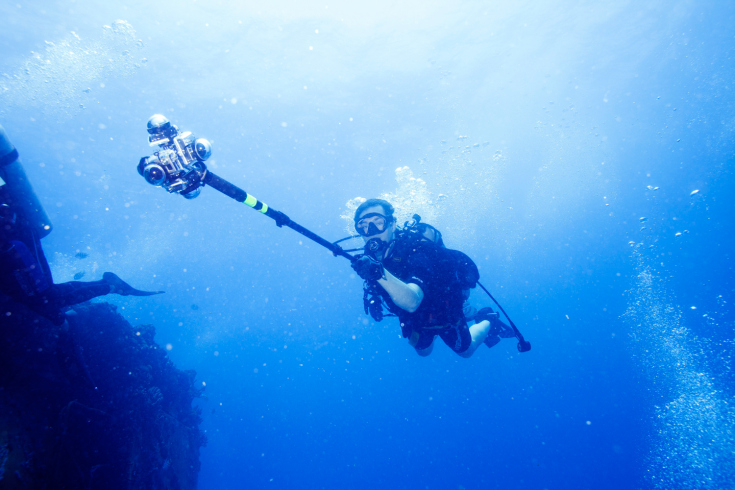Interactive video experiences have developed into a powerful medium with the advance of 360 video technology. TIME Magazine‘s “Deep Dive” represents one of most recent and high-profile instances of this medium’s use as a story-telling tool. In this case, the story being told was that of famed oceanographer Fabien Cousteau and his latest project Mission 31.
TIME was tasked with finding a way to deliver Aquarius, the world’s sole underwater research facility, to its audience in an engaging and informative manner. In hopes of utilizing 360 video to convey the sensation of diving with Cousteau, TIME reached out to 360Heros CEO Michael Kintner.
From this conversation a collaborative project was born in which Jonathan Woods, TIME’s Senior Editor, planned to dive with 360Heros gear and capture Aquarius from a firsthand perspective. The result was the creation of an interactive piece of journalism offering viewers a tour of Cousteau’s facility.
Following the release of “Deep Dive”, we caught up with Woods to get his take on diving with 360Heros gear and immersive video as a medium.
360Heros: I know you utilized panoramic photography for TIME’s World Trade Center piece “The Top of America“, was “Deep Dive” your first project employing 360-degree panoramic video?
Jonathan Woods: This was the first project TIME has ever done with 360 video. We looked at how we could bring this to TIME’s audience. We had to see who had solutions for this. What we found was a sparsely populated landscape.

360: How did you first discover 360Heros and our immersive video technology?
JW: Mia Tramz, a photo editor specializing in science and space, pitched and produced the project. She started looking for people who were creating solutions for capturing and displaying 360 video. From what we could find, 360Heros appeared to be the best solution.
360: What were the biggest challenges you faced in filming the dive footage?
JW: We were looking at filming 3 takes and each of the takes presented their own challenges. First, when you’re dealing with 6 independent cameras your risk of failure goes up exponentially. It’s one thing if you’re using one camera, but when you’re shooting 360° video, any number of things can compound your rate of failure; a battery that’s not 100%, one wrong setting or a housing that leaks, there’s a lot of things to be concerned about in terms of being sure that you have contingencies in place just in case something goes wrong.
Just by design we ended up trying for 3 takes because of the nature of the project. Because this was the first time we had attempted this, there was a great deal of interest internally at TIME and we wanted to be sure that we came away with something impactful.
To speak specifically to some of the biggest challenges, I had received the 360Heros gear but I’d only had the opportunity to train and dive in a pool with it. I had to do my best to share best practices with a photographer who had not used 360Heros gear before. We ended up creating diagrams for him and supplemented our instructions with skype chats and phone calls.
You have to remember, he was already living underwater at that point. We were shipping him technology that had to be transported down in pressurized pods. Electronics present a lot of challenges when you bring them underwater. You run the risk of serious failure if you don’t slowly equalize those pots due to the 3 atmospheres of pressure. That was a challenge we hadn’t expected having to solve for. It quickly became apparent that this wasn’t going to be your typical everyday dive.
On the day of the second dive, the dive I was down on myself, we were facing low visibility and incredibly strong currents. Notably, one of the settings on one of the cameras was off. So that foiled the video that I captured. Although we saw some really cool stuff, the stitching of that video was impossible.
Fortunately on our 3rd shot at it, Brian Hall, who was one of the Mission 31 photographers, absolutely knocked it out of the park. He did everything perfectly and we were able to capture one continuous take that was 3 1/2 minutes long, which was a perfect length for us to be able to efficiently and thoroughly convey what it is like to go down near Aquarius, what it is like to scuba dive with Fabien Cousteau.
360: In reference to shooting and presenting viewers with one continuous shot:
JW: One thing that I’ve noticed looking at 360° videos, if you’re looking at one 16×9 frame of video that’s static, not 360°, you’re looking at a moving picture. It’s already challenging enough to hold your attention and make that feel natural. With 360° video this issue is amplified, as cutting from scene to scene can be a very disjointed experience from a user’s perspective.
Transitioning between cuts, viewers would likely have to reorient themselves, which can be jarring. This is especially true in the context of a 360° video on the web. Having one continuous shot without cuts offers viewers an uninterrupted experience.
Considering immersive video’s adaptability, why did you choose this project in particular for TIME’s first 360 video production?
JW: Everything that was happening with Mission 31 at the surface level seemed very difficult to comprehend from a user’s point of view. A lot of what I do is trying to figure out how to get people to engage with the stories we tell. This involves deciding what platform is best to tell a particular story.
When I first met with Fabien I knew he had a very worthwhile cause and an interesting project. I had to find a way to get people into this story that was going to hold their attention. Mia, who was doing the brunt of the research on this project, brought 360Heros to the table and it just fit what we wanted to accomplish. What a cool way to get people down there to experience this habitat.
He’s living down there for 31 days in something the size of a school bus. With this technology we were able to allow people explore it, to go on a scuba dive with Cousteau.
What are your thoughts on panoramic video as a medium?
JW: It’s a tool for telling stories. Just like with the World Trade Center project that involved one continuous panorama. It’s a means to an end. A means to give us an opportunity to tell a story in an engaging way.
What I want more than anything is for people to come to TIME to feel that they’re getting stories in an innovative, engaging and informative way. This project and this technology is the latest chapter of innovations.
From the perspective of a photographer and cinematographer, what does immersive video offer in terms of expression and storytelling?
JW: It’s a completely different beast because you have to understand that for 360° underwater video to work, the cinematographer becomes part of the story. Unless you’re mounting the gear on an underwater drone, you’re right there capturing the footage and seeing it firsthand.
It’s a very unique tool that I think is in its early stages of being deployed and utilized in a way that fully harnesses the power of the technology.
360: Do you have any future plans to utilize it in your work?
JW: We’re definitely hungry to find the next story to use 360 video. We still need to find out what that is, but absolutely. In the context of our ever-growing box of tools that we use to capture stories, 360 video is definitely one we want to use again.
Now that we’ve used it before, we want to refine the process and do it again – which is exciting.
360: Could you comment on your experience working with 360Heros?
JW: Any partnerships that we do involve me conveying an understanding to whoever we’re partnering with what the goals of the project are and developing a mutually beneficial relationship.
From this project’s inception, Mike was very open and eager to discuss how the video would be implemented on the site. The difficulty came more on TIME’s side with Mike helping us understand the challenges we would be up against and helping us be able to do what we needed to do on very tight deadlines.
When things started moving very quickly, Mike shuffled his schedule around and helped us push it out the door on time. Without his assistance we wouldn’t have been able to publish this project.
360: Jonathan, thank you so much for your interview and your dedication to making this project possible.
Jonathan D. Woods is the Senior Editor of Photo and Interactive for TIME.com.
© 2011-2014 360Heros™ is a 360Heros Inc Company. GOPRO®, HERO® are trademarks or registered trademarks of Woodman Labs, Inc. in the United States and other countries. 360Heros, Inc. is not an affiliate of GOPRO® or Woodman Labs, Inc. 360Heros is a very proud user of GOPRO® cameras! 360 Heros creates 360° Video using GoPro Hero2 and Hero3 cameras. Check out our gear, sign up for updates, and explore the 360° videos and 360° panoramic photos created with the different 360 Plug-n-Play Video Gear.



You must be logged in to post a comment.